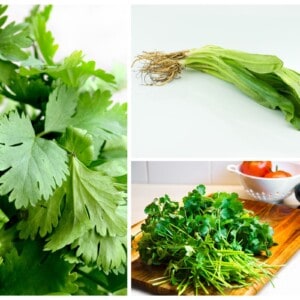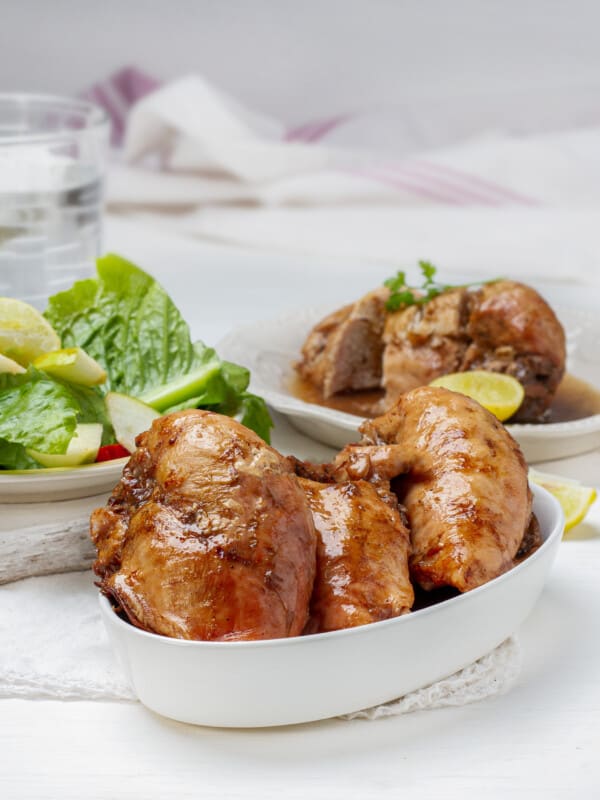Dive into the world of culinary herbs with our comprehensive exploration of culantro and cilantro. These aromatic greens have similar names and flavors but feature key differences. In this guide, we’ll unpack their unique characteristics, uses, and roles in international cuisine, ensuring you’re fully equipped for your next culinary adventure.
Culantro vs. Cilantro
Two vibrant green herbs, distinctive flavor profiles, and completely different plants. Culantro and cilantro often stir up confusion due to their similar names and similar flavors. Both are trendy ingredients in culinary settings around the world, with each one bringing a unique taste and intensity to a wide range of dishes. We’re going to take a journey through their similarities, their differences, and the specific uses of each in cooking.
What Is Culantro?
Culantro, known scientifically as Eryngium foetidum, is a perennial herb native to the tropical Americas. While it has a name very similar to cilantro, they are very different spices, and each has its unique character. Culantro, which is also known as recao, long coriander, and false coriander, has long, serrated leaves and is prized for its remarkably intense flavor.
With regard to its taste, culantro is commonly described as a more potent version of cilantro, bearing a stronger aroma and far more concentrated aroma. Unlike cilantro, it retains much of its flavor when cooked, which makes it a valuable ingredient in the stews, soups, and chutneys of various cultures. It’s very common in Caribbean, Central American, and even Asian cuisines.
The resilient nature of the plant, along with its robust flavor makes it a highly versatile and valuable ingredient in many traditional and contemporary recipes. From the aromatic broth of a delicious Vietnamese pho to the distinct notes in a Trinidadian pelau, culantro makes itself known whenever it’s used.
Different Types of Culantro
Even though there’s only one species of culantro, the regional and cultural variations give a sense of its reach and use in the culinary world. Central Americans refer to it as “alcapate,” and it’s a cherished ingredient in many local traditional dishes. In Asia, particularly in Vietnam, culantro is known as “ngo gai” and adds depth to pho and other soups. The Caribbean version, known as chadon beni or bandhaniya, is widely used in traditional family dishes.
How Do You Use Culantro
Unlike many other herbs, culantro is able to maintain its robust flavor through heat and long cooking times, which makes it incredibly adaptable to almost any kitchen. For the best results, the leaves need to be rinsed thoroughly and then finely chopped before being added to your dish. In this manner, it can be used in salsas, chutneys, and even salads, or used to add depth to soups, stews, and rice dishes. Culantro’s intense, nearly pungent taste, means that it should be used sparingly, as a little goes a long way. Start small, and adjust to your taste.
Delicious Culantro Ingredients
Due to its flavor profile, culantro is an ideal match for countless ingredients, helping to create more flavorful yet balanced recipes. It goes very well with beans, rice, lentils, meats, and other ingredients that help complement the flavor including lime, garlic, tomatoes, onions, and even chilies. When you use culantro with ingredients like that, it adds a more complex flavor profile without being overpowering. Whether you’re cooking up a Caribbean classic or simply experimenting with your own ideas, culantro is a great way to elevate your culinary experience.
Great Culantro Recipes You Should Try
- Trinidadian Pelau: This one-pot dish featuring chicken, rice, and pigeon peas is infused with the bold flavor of culantro, known locally as chadon beni.
- Vietnamese Pho: This traditional noodle soup gets an extra layer of depth from culantro, called ngo gai in Vietnamese. Just a few leaves can transform this comforting dish.
- Caribbean Green Seasoning: This mixture of fresh herbs, including culantro, garlic, and peppers, is a versatile marinade that can be used on meats, poultry, and fish.
What Is Cilantro?
Cilantro, or Coriandrum sativum, is an annual herb in the greater family of Apiaceae. It’s well-known for the distinctive, fresh flavor that is the source of constant division in the culinary world, as people either love it, or they hate it. The whole plant, from the leaves to the seeds (known as coriander), is edible and used in countless cuisines around the world.
Unlike culantro, the leaves of cilantro are very small, delicate, and almost feather-like, while visually resembling Italian flat-leaf parsley. Cilantro brings a fresh, citrusy element to dishes, making it a staple around the world, being prevalent in Mexican, Indian, and Middle Eastern recipes. It’s often used raw and added at the end of cooking to maintain its flavor, which can be eliminated by heat.
Different Types of Cilantro
There are a few different types of cilantro, with each one having a unique flavor as well as growth characteristics. The most common is Coriandrum sativum, and there’s also Vietnamese cilantro, known for its spicy flavor, and the Confetti cilantro, named for its finely serrated leaves. Each cilantro variety lends a slightly different taste and flavor profile, making cilantro in general, one of the most versatile herbs for experimentation.
How Do You Use Cilantro
Cilantro is most commonly used while still fresh since it has a very delicate flavor that can be destroyed by heat and cooking. The best way to use cilantro in your cooking is to make sure the leaves are washed thoroughly, then pat them dry, and finely chopped. Due in no small part to its subtle taste, you can use a generous amount in your recipes without being overbearing or overpowering other flavors.
It works beautifully in raw dishes like salsas and salads, as well as in the role of a garnish when used for soups, curries, and grilled meats. The biggest thing to remember, however, is to add it only at the very end of the cooking stage, just after cooking is finished, or just before serving. This keeps the flavor profile intact and avoids diminished or even burnt flavors.
Delicious Cilantro Ingredients
Cilantro is able to pair very effectively with a wide range of ingredients. The bright, lemony flavor is the perfect complement to spicy foods, and it’s a great addition to dishes containing avocado, lime, tomatoes, and beans. Try it as a finishing touch to any chicken, fish, or vegetarian dishes as well. The unique combination of cilantro with ingredients like garlic, onions, or chilies adds a vibrant touch to your culinary creations. Cilantro is a key ingredient in many traditional dishes, like traditional Mexican guacamole, Indian chutneys, Thai soups, and many more.
Great Cilantro Recipes You Should Try
- Mexican Guacamole: This beloved avocado-based dip is elevated by the fresh flavor of cilantro. A must-try for any avocado lover.
- Thai Green Curry: Cilantro’s citrusy notes perfectly balances the rich, creamy, and spicy flavors of this classic dish.
- Indian Cilantro Chutney: This bright green sauce made with cilantro, green chilies, and lime juice is a versatile condiment that adds a zesty kick to a variety of dishes.
Wrapping Up: What are the Key Differences Between Culantro and Cilantro?
While culantro and cilantro share some flavor profiles and similar names, they are very distinct herbs with unique characteristics. The biggest differences are in their appearance, potency of flavor, and heat resistance.
Culantro has long, serrated leaves and a stronger flavor that is able to withstand cooking. On the other hand, cilantro has a delicate, parsley-like leaf and a much milder taste that is best preserved by waiting until the end of the dish to add them.
Both herbs are highly versatile and can be used effectively in a variety of dishes. The biggest choice between culantro and cilantro will lie in what flavor profile specifics you’re looking for.
Frequently Asked Questions (FAQs)
Q1: Can I use culantro and cilantro interchangeably?
You can substitute culantro for cilantro and vice versa, but keep in mind they have different flavor intensities. Culantro is much stronger, so if you’re substituting cilantro for culantro, you may need to use more, and be sure it’s only added at the very end, to avoid damaging the flavor profile with cooking.
Q2: Are cilantro and coriander the same thing?
The answer is going to largely depend on what part of the plant you’re talking about, and where you live. In the United States, “cilantro” refers to the leaves and stems of the Coriandrum sativum plant, while “coriander” refers to the seeds. However, in many other parts of the world, “coriander” is used to refer to the entire plant.
Q3: What can I do if I don’t like the taste of cilantro?
Cilantro’s flavor can be divisive, and those with a specific genetic component find that it tastes like soap. If you’re among those who don’t enjoy it, you can try substituting it with flat-leaf parsley or even culantro for a more robust flavor. Remember, cooking tends to mellow out the flavor, so you might find cilantro more palatable when cooked.
Culantro vs Cilantro

Instructions
- choose your favorite recipe
- click the link to view the instructions
- follow the linked instructions
- enjoy





